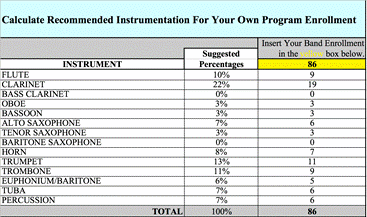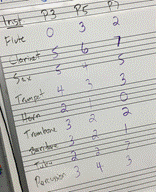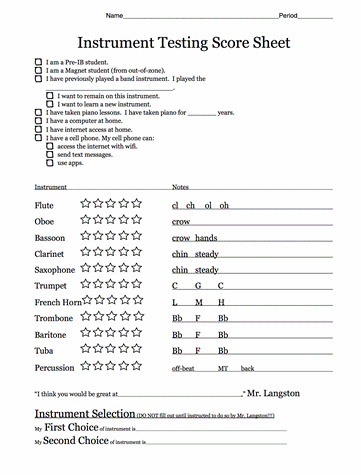Part 3: Establishing a Balanced Instrumentation
Submitted by Josh Langston,
Band Director,
Millennium Middle School
Seminole County Public Schools
The final task of the Beginning Band Instrument Fitting and Evaluation period is that of achieving a balanced instrumentation within your ensemble. Not only will this task allow you to establish appropriate ensemble sounds in your beginning bands, but it effectively establishes the instrumentation for the next two to three years of your bands!
Establishing a balanced instrumentation is often tricky because of factors that affect student choice. These factors include:
- students/parent preconceived notions about what instrument they would like to play or have their child play
- ownership of an instrument already in the family
- ability to financially support their instrument of choice
- ability to transport the instrument of choice
- preconceived ideas about instrument stereotypes
Many of these obstacles can be avoided or overcome using two main strategies: Information and Positive Reinforcement.
Students and families have to be informed about balanced instrumentation if it is to be achieved. When they understand the reasons why they all cannot play saxophone or drums, they tend to become more amenable to being a "team player." A great way to begin this conversation is to use their prior knowledge as a starting point. For example, football is a huge part of the community our school serves. Using analogies of sports team-building go a long way to help establish the idea of being a team player. Most people will understand that not everyone can be the quarterback and that a particular skill set is needed for each position. At the end of the Instrument Fittings, each student will have an idea of his or her skill set.
Another great analogy is that of cooking and the use of recipes. Most students can relate to having followed a recipe or even experienced the failure of not having followed one correctly. For example, when baking cookies, the amounts of the ingredients used will affect how the cookie bakes and holds its shape, how the colors change, and ultimately, how it tastes. The concept of balanced instrumentation can be likened to that of a "recipe for sounding great!"
An excellent visual that I use with students and families is the Instrumentation Calculator. This is an excel spreadsheet that displays instrumentation as a formula. When the director enters the number of beginning students, the spreadsheet then generates the number needed for each instrument. (These percentages can be adjusted to fit the director's ideas for balanced instrumentation.)

Click Here to Download an Instrumentation Calculator
Throughout the process, I keep a tally on the board showing the number of instruments chosen in each class. Over the course of days (usually three), I talk to each class about needing more of this and less of that. Additionally, I target students who have either made questionable decisions or have multiple successes and could potentially solve problems.

Positive reinforcement is the final element in establishing instrumentation. This is not something you save for the end of the process, but distribute during the process. You have to really sell students and families that the sound that was made on an instrument was successful! Your salesmanship and positive statements about how a student did will begin to shape a student's choice on what he or she will choose to play. A basic blueprint for this is:
- demonstrate excitement or joy when a student makes a great sound on an instrument!
- write down student successes (and failures)
- refer to the success when selection time has arrived
I have found that referring to the success a student experienced during fittings has been indispensable during this phase. Recently, during an instrument consultation, I was testing a student who had proclaimed his love for the drums based on his experience from being in his elementary school drum line. During the fitting, I handed him a baritone, which he then proceeded to play 4 partials up and down with complete control and beautiful tone! My eyes popped open wide, and I snapped my head over to look at mom, whose eyes had done the same! With a huge smile on his face, he walked out of the room, with he and his mother sure that he was going to be an epic baritone player! When asked to make his decision on an instrument, he said "Baritone…because I remember the look on your face!"
I share this anecdote because it best demonstrates the immediate success positive reinforcement can have. I never even had to say anything; my reaction to his playing was the reinforcement he needed!
Keeping track of student successes is extremely useful, especially in cases where a student's path is not as obvious as the star baritone player. Some students may score well on many things or none at all. In each case, you can reinforce a projected path of success. One student may be amazing at whatever instrument is chosen, while another is "super close to the right sound, but will need a little more time" to get the hang of it. Having a record on hand of how they tested on each instrument allows you to refer to their successes and failures when it comes time to make the decision. Below is an example of an instrument fitting score sheet. It includes information that may come in handy when making sound recommendations to students:
- a numerical scale for rating a student's success on each instrument
- a place for notes and observations made during fittings
- a place to note any previous musical experience
- a place for students to list their choices
- a place for the director to make a recommendation
- a place to make note of other factors the director finds useful

Click Here To Download An Instrument Testing Score Sheet
Finally, when asking students to make their instrument selections, the above tools will make it easier to outfit your band with appropriate instrumentation.



